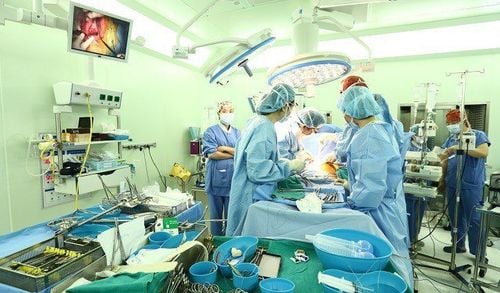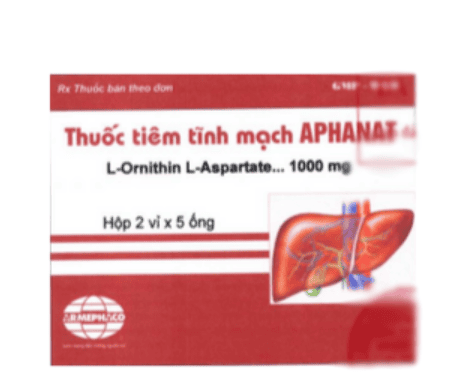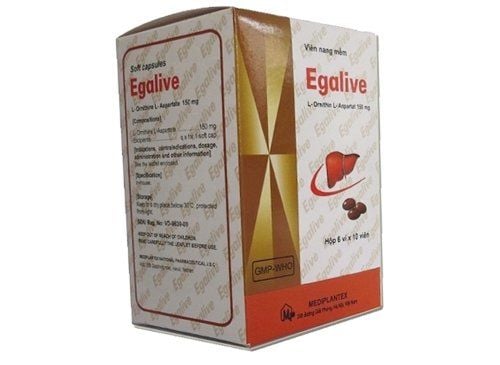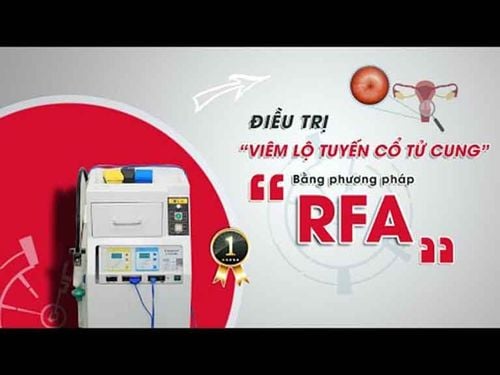This is an automatically translated article.
The article is expertly consulted by MSc Duong Xuan Loc - Gastroenterologist - General Surgery Department - Vinmec Danang International General Hospital.Radiofrequency ablation of liver tumors gives good results for tumors less than 5cm in size. Especially in the cases of less than 3 tumors and the tumor is smaller than 3cm, the method has the same effect as surgery and has fewer complications.
1. Liver tumor and treatment
Liver tumors are the first and most common manifestation of liver cancer. However, liver tumors can also be benign and cause almost no complications.The time of detection and treatment of liver tumors is decisive for the patient's survival. In fact, if liver cancer is detected early when the tumor size is less than 3cm (at this time the liver is just fibrosis), the 5-year survival rate can be up to 80-90%. If the tumor is already larger, in the range of 3-6cm, the ratio will be reduced to 60%.
Current treatment methods for liver cancer are mainly surgery and non-surgical interventions.
1.1 Liver cancer surgery 1.1.1 Liver resection If the patient does not have a history of cirrhosis, doctors often recommend hepatectomy because this is a treatment with a relatively low mortality rate and time. Long-term survival after surgery reaches 50-60%. Currently, laparoscopic liver resection is also applied in cases of liver tumors that are favorable for laparoscopic surgery.
1.1.2 Hepatic artery ligation Is a temporary treatment, indicated for cases where there is no longer the ability to cut the liver. This treatment causes necrosis in the center of the tumor, which relieves pain and shrinks the tumor.
1.1.3 Liver Transplant Liver transplant is an indicated method in case of a healthy donor liver. The method is suitable for liver cancer patients with tumors less than 5cm in size and no more than 3 tumors over 3cm in size, tumors that have not invaded blood vessels.

1.2.1 Radiation therapy for liver cancer The development of technologies High-tech radiotherapy techniques, such as intensity modulated radiation therapy (IMRT) and body position radiotherapy (SBRT) allow for further increase in radiation dose.
These are high-precision forms of radiation therapy that use multiple beams to deliver high doses to the target tissue with a rapidly decreasing dose outside of the target tissue, thus minimizing the dose received from adjacent normal tissues .
1.2.2 Percutaneous ultrasound-guided destruction of liver tumors Used for patients with early or mid-stage liver cancer who are not suitable for surgery. Patients with less than 3 liver tumors with a size of 3-4 cm and accessible by ultrasound guidance will be indicated for this therapy. Therapy to destroy liver tumors through the skin under the guidance of ultrasound includes: Injection of chemicals into the tumor and treatment of cold (cryotherapy), microwave (microwave), radiofrequency, laser, ...
1.2.3 Other methods Embolization via selective hepatic angiography TACE Chemotherapy Immunotherapy.
2. Burning liver tumors with high-frequency waves
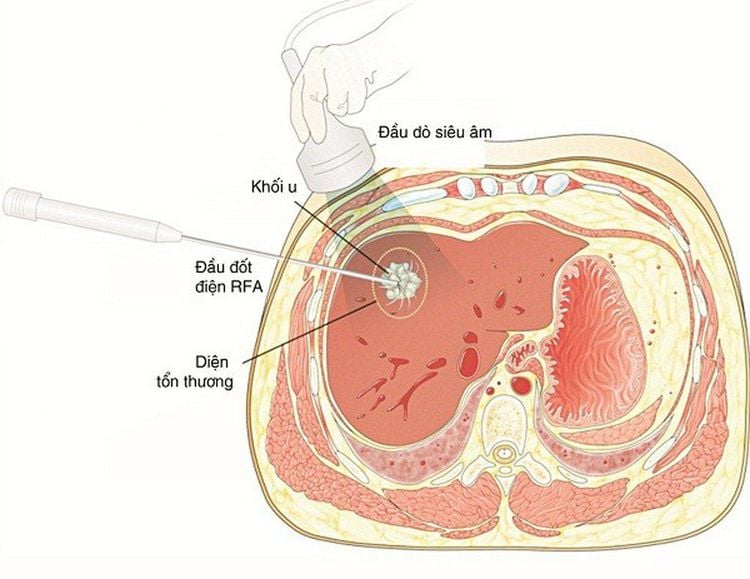
These cases do not require surgery, burning liver tumors with high-frequency waves for the same effect, low complications.
Burning malignant liver tumors by radiofrequency is also used for palliative treatment in cases of tumors > 5cm, multiple tumors (over 3 tumors, each > 3cm); There may be extrahepatic metastases or incomplete portal vein thrombosis.
The technique is currently considered an effective treatment equivalent to surgical resection of liver tumors less than 3 cm in diameter.
2.1 Advantages of radiofrequency ablation The advantage of this method is that it does not cause damage to the surrounding healthy tissue. The technique is simpler, does not require a team of anesthesiologists as complicated as surgery to remove liver tumors. After a few hours of performing the technique, the patient can have normal activities, the complication rate is very low..
Burning liver tumors with high frequency waves can be used in combination with embolization with chemotherapy in some cases. specifically to increase efficiency.
2.2 Working principle of the ablation machine The high frequency radiofrequency ablation machine uses AC electricity to convert it into heat. When the temperature is about 50 degrees Celsius, the transformed tissue cannot be restored; temperature from 50 - 600C, protein coagulation necrosis and cell death in a few minutes; At temperatures above 60°C, cell death occurs immediately.
We only need to use an ultrasound machine with a 3.5 -5 MHz curved probe to ultrasound the hepatobiliary system, locate the tumor, then use a special needle to destroy the tumor. It takes between 15 and 40 minutes, depending on the specific case.
In order to achieve the highest diagnostic and treatment efficiency, Vinmec has equipped the most modern imaging equipment system today, typically the GE Healthcare S9 ultrasound machine with flat transducer, high frequency, HD resolution for clear images. Radiofrequency ablation technique to treat thyroid tumors under ultrasound guidance allows the doctor to control the entire procedure, avoiding damage to blood vessels, nerves, trachea, esophagus, so it is very safe. while reducing the maximum tumor size.
Periodically after 1 - 3 - 6 months, the patient will be re-examined with an endocrinologist and radiologist who has directly performed the procedure for the most accurate and objective assessment results.
Master. Doctor Duong Xuan Loc has more than 12 years of experience as a Gastroenterologist and is currently a Gastroenterologist at the Department of General Surgery - Vinmec Danang International General Hospital.
Please dial HOTLINE for more information or register for an appointment HERE. Download MyVinmec app to make appointments faster and to manage your bookings easily.






